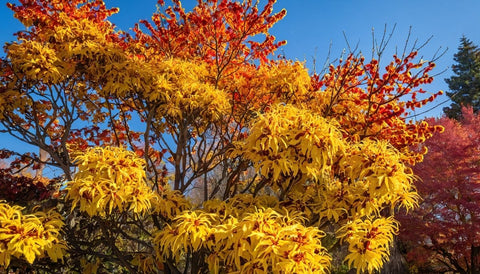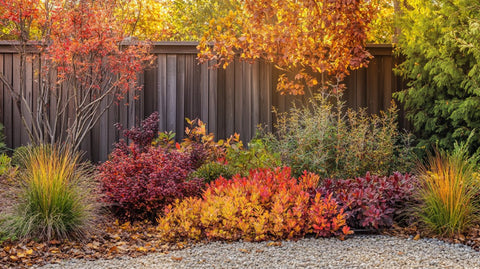Introduction
Ah, fall—when nature paints the landscape in vibrant hues of orange, yellow, and crimson. While many of us adore the beauty of autumn foliage, one often-overlooked shrub can add a unique flair to your fall garden: the Witch Hazel. This fascinating plant not only dazzles with its superb fall colors but also brings a wealth of history and charm to your landscape. Let’s dive into why Witch Hazel should be a staple in your fall garden!
What is Witch Hazel?
A Botanical Overview
Witch Hazel, scientifically known as Hamamelis, is a deciduous shrub celebrated for its ability to bloom stunningly during winter and offer autumn color that can rival any maple tree. With its striking, serrated leaves that range from green to golden yellow in the fall, and delicate, ribbon-like flowers that can appear as early as February, Witch Hazel is a true garden gem.

Different Species and Cultivars
You'll find various species of Witch Hazel, like Hamamelis virginiana, known for its simple care aside from its artistic form, or Hamamelis x intermedia, which showcases more vibrant flowers. Each cultivar offers something a bit different, making it easier to find the perfect fit for your garden.
Historical and Cultural Significance
Did you know that Witch Hazel has also played an important role in traditional medicine? Native Americans utilized its bark and twigs for medicinal purposes, and today, extracts are common in skincare products thanks to their soothing properties.
The Beauty of Fall Color
Understanding Fall Leaf Coloration
Have you ever wondered how leaves change color in the fall? As daylight shortens and temperatures drop, chlorophyll breaks down, unveiling the brilliant yellows, oranges, and reds hidden underneath. Witch Hazel is no exception; its leaves can glow in shades of golden yellow to fiery orange and deep red, depending on the specific cultivar.
How Witch Hazel Compares
When standing amongst the sea of fall foliage, Witch Hazel stands out for its unique ability to provide a delicate contrast. Instead of the bold colors typical of many trees, Witch Hazel offers a softer, almost ethereal glow that complements its vibrant neighbors beautifully.
Planting Witch Hazel
Best Planting Locations
When scouting for the perfect spot to plant Witch Hazel, consider areas with well-drained soil and partial sun to full shade. While these shrubs can tolerate varying conditions, they prefer slightly acidic to neutral soil.
Tips for Planting and Spacing
Give your Witch Hazel some breathing room! These shrubs can grow anywhere from 10 to 15 feet tall and wide, so plan to space them at least 8 to 10 feet apart to allow for healthy growth.
Caring for Witch Hazel
Watering and Fertilization Guidelines
Witch Hazel is relatively low on maintenance. Water it regularly during dry spells and consider applying a balanced fertilizer in early spring if the growth appears sluggish.
Pruning Techniques
To maintain its shape and health, prune your Witch Hazel after flowering, removing any dead or cross branches. This encourages healthy growth and allows more sunlight to reach the inner branches.
Pest and Disease Management
Though generally resilient, keep an eye out for common pests like aphids or spider mites. A gentle spray of water or organic insecticidal soap can keep them at bay.
Combining Witch Hazel with Other Fall Foliage Plants
Suggestions for Companion Plants
Pair your Witch Hazel with companion plants like ornamental grasses, or in groups with smaller shrubs like dwarf burning bush for a captivating layered effect. The combination of textures and colors can create a visually stunning autumn display.
Considerations for Layering
Think about heights and shapes when designing your fall landscape. The delicate stature of Witch Hazel benefits from being paired with taller plants like Joe Pye weed in the back and shorter plants in the front.
Benefits of Adding Witch Hazel to Your Garden
Year-Round Appeal
Witch Hazel isn't just a fall superstar—thanks to its winter flowers and an attractive growth habit, it adds interest to your garden throughout the year.
Attracting Wildlife
If you're eco-conscious, know that Witch Hazel is great for local wildlife. Its flowers provide nectar for pollinators in winter, while its foliage offers shelter for various birds.
Low Maintenance and Versatile
Witch Hazel is adaptable to different soil types and conditions, from wet areas to dry spots. Once established, it requires minimal care, making it perfect for seasoned gardeners or those still learning the ropes.
Conclusion
Incorporating Witch Hazel into your garden brings a refreshing touch of fall color and an array of benefits. From its captivating foliage to its wintry blooms, this shrub undoubtedly deserves a prime spot in every garden. So, why not give it a try this fall? Visit your local nursery, ask questions, and consider planting this stunning shrub in your landscape. Have experience with Witch Hazel? We'd love to hear about it! Share your thoughts in the comments.






























Comments (0)
There are no comments for this article. Be the first one to leave a message!